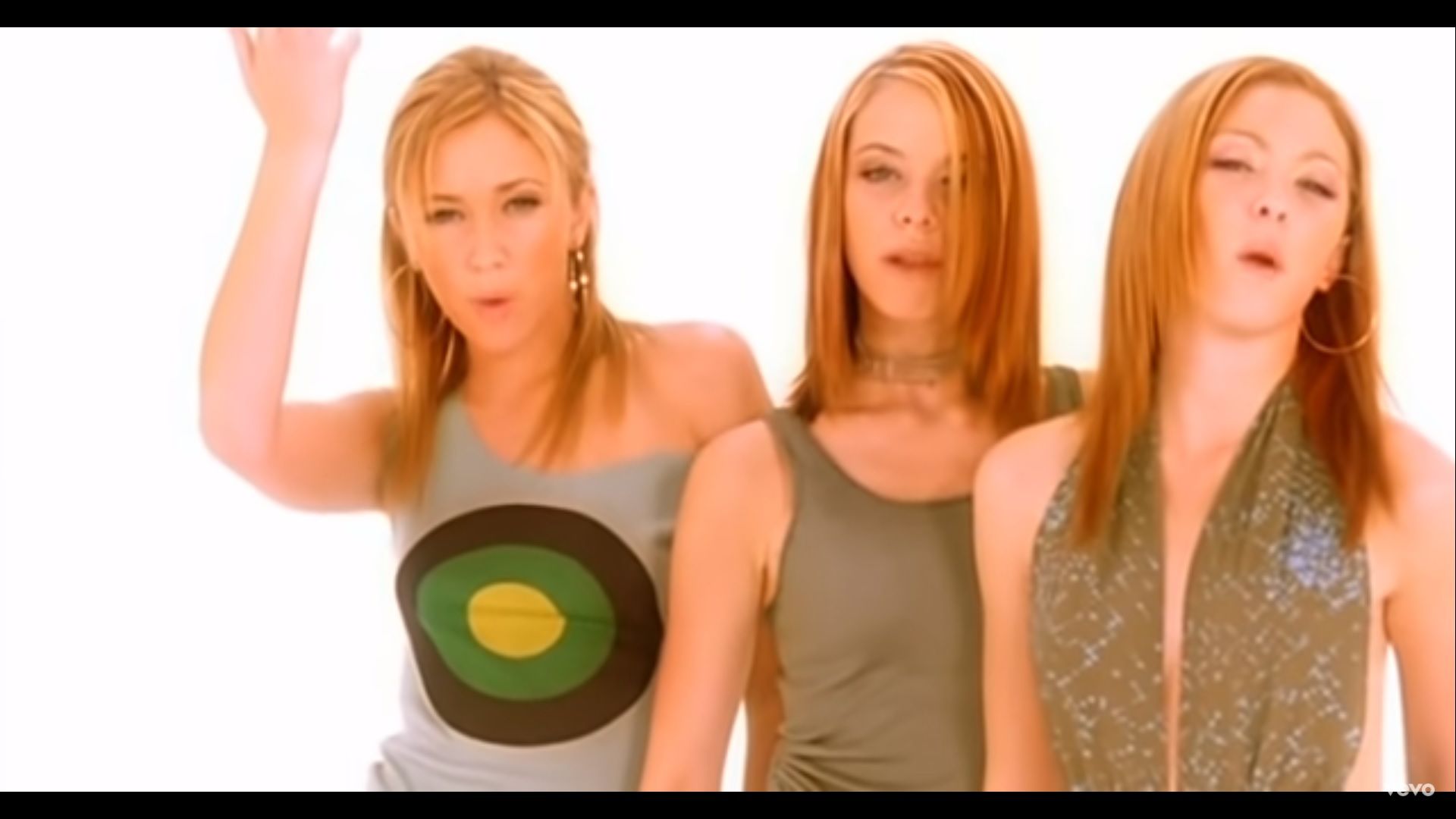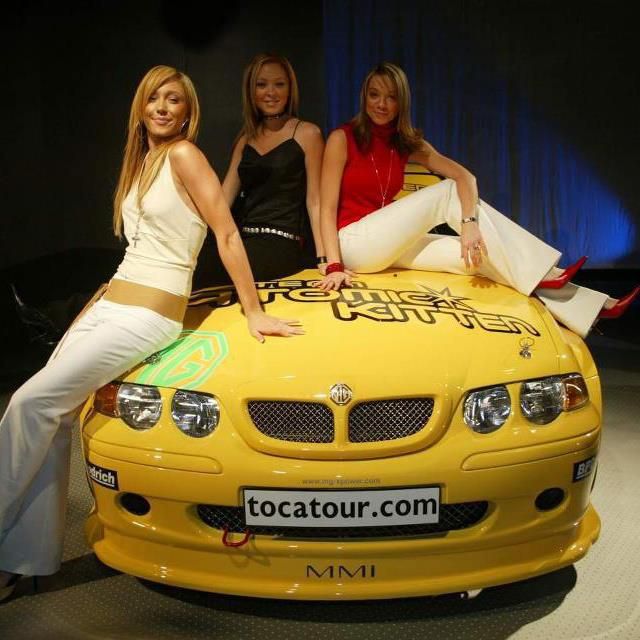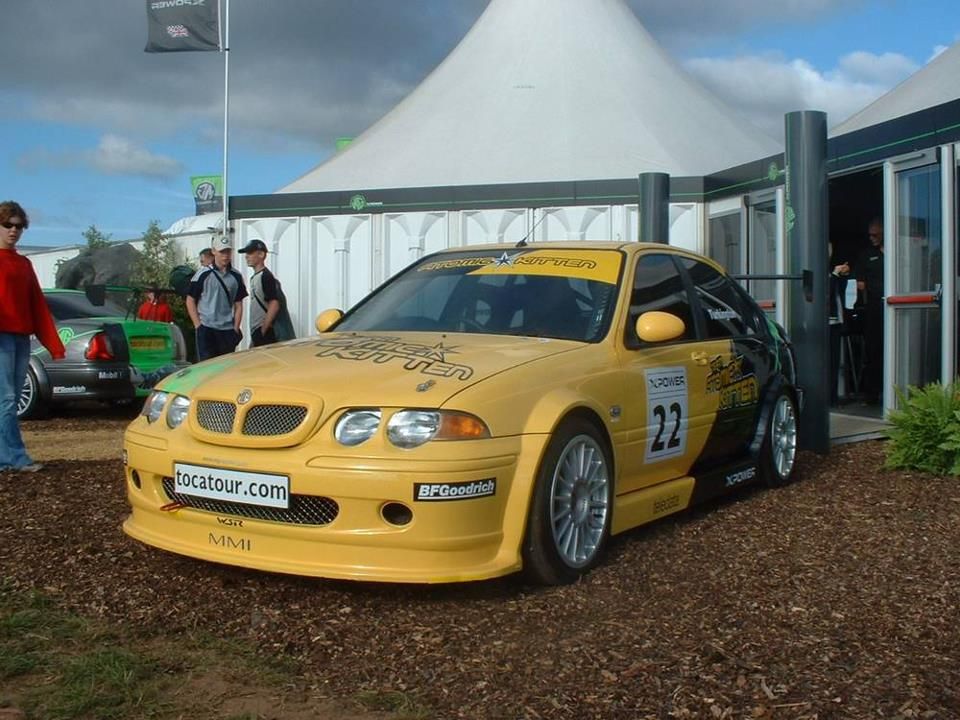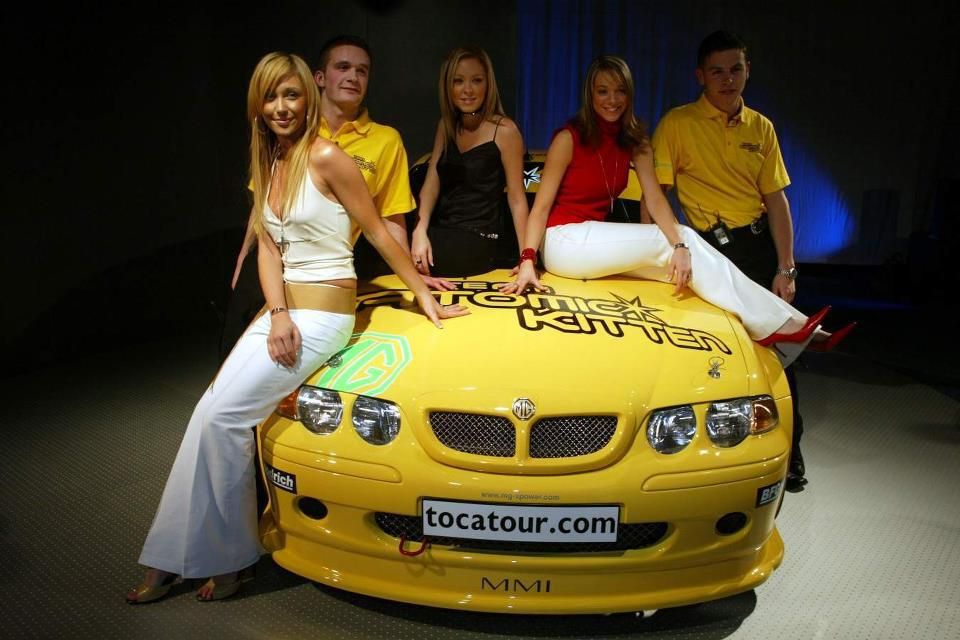We're in the early noughties. Everyone's got Walkmans or iPod Nanos, everyone wears slightly oversized pants and shirts, and everyone blends colors that, really, shouldn't be blended. Then there's the music people are listening to as hard-edged stuff like metal, alternative, and grunge take a step back allowing electro-pop to take over with all its glitzy overtones. Riding the wave are numerous boy bands and girl bands that end up everywhere on the walls of kids and teens and among the myriad of groups there's one called 'Atomic Kitten'.
The name is dubious but behind it lay a number of UK and European chart-topping hits that can still be found lurking through many compilations of '00s British pop. At one time hailed as the "biggest girl group in Europe," Atomic Kitten sold eight million records in less than a decade and traveled the continent jumping from arena to arena. We aren't interested in all that but what we are interested in is what Atomic Kitten endorsed at one point in the band's lifespan and that is, oddly enough, motorsports.
Sponsorship, the end-all and be-all of racing
Racing is hard. It pushes man and machine to the limits of their durability, it brews rivalries and tension, and, if you want to be at the top of the game, it basically becomes your way of life. Another important piece of the puzzle for those at the top of the game is funding which can be hard to come by at times meaning teams and drivers call on just about anyone for financial support.
In the past, tobacco companies jumped at the opportunity to get some much-needed exposure by plastering their names and logos all over the silhouettes of racing cars. Back in the '60s, when this practice kicked-off, racing was one of the world's most popular sports and Formula 1 its globe-trotting poster boy. As such, it wasn't just the tobacco industry that poured dollars into this fast-paced and dangerous sport - in fact, everyone wanted a piece of the action. From airline companies to hotels, makers of daily products, shop owners, and chemical companies, all jumped on the bandwagon. Even adult magazines appeared on the sides of racing cars in the past as did one of the most famous condom-making companies.
Given the interest motor racing was drawing (in many countries throughout the '60s and '70s, motorsports events were the single largest one-weekend people-gatherers beating everything from football matches to music concerts), it isn't particularly weird to note that one John Bonham helped Kaye Griffiths’ McLaren M8E/D make the grid of 1974's Martini International Trophy Supersports event at Silverstone. With Bonham being the drummer of Led Zeppelin, Griffiths' Group 7 monster took over a rather intricate design with 'Led Zeppelin' written on the car's sides. While that particular event ended with a retirement for Griffiths, nobody could forget the so-called Led Zeppelin McLaren that would go on to retain that famous color scheme up until the present day.
But beyond's Led Zeppelin's momentous involvement to help a lesser-known driver compete in British Formula Libre event, which was anyway mostly fueled by Bonham's passion for cars that extended to driving 260 mph dragsters down the strip at Santa Pod, not many musical acts sensed that there could be a return of their investment if they were to throw dollar signs at a driver or a team. Sure, guys like Andrew Ridgeley (the other half of 'Wham!'), Shane Lynch (of the band 'Boyzone', who shifted from the British GT to drifting) and, more notably, French superstar Johnny Hallyday all competed as drivers but received no backing from their respective bands. That's why Atomic Kitten's special.
The 'Kittens' could sing!
First off, let's go back in time to the late '90s to trace the roots of Atomic Kitten. Coming out of Liverpool, the band was formed by former 'Orchestral Manoeuvres in the Dark' (OMD) members Andy McCluskey and Stuart Kershaw. It all happened in 1998, two years after OMD split at the suggestion of Karl Bartos, himself a former member of electronic giants 'Kraftwerk'. McCluskey and Kershaw would be the band's songwriters while Liz McClarnon, Kerry Katona, and Heidi Range were brought in to perform the songs. Range, however, defected and ended up with 'Sugababes' and Natasha Hamilton was picked to replace her.
The trio released its first single, 'Right Now', towards the tail end of 1999 as Britpop was the chart-topping genre in the Isles. That maiden single immediately vaulted to number 10 in the UK Singles Chart and was followed by the No. 6 single 'See Ya'. With momentum on their side, the girls released their first album, also named 'Right Now', that first appeared in Japan in the Spring of 2000. While a subsequent single topped the charts there, Atomic Kitten, as the trio had been known basically since its inception, found the European and the British crowd respectively to be much less appreciative of its sound to the point that its label considered dropping them.
However, in a last-gasp attempt to make it on home soil, Atomic Kitten released 'Whole Again' which promptly reached No. 1 in the UK and 18 other countries following its international release. By then, original member Kerry Katona was no longer part of the band after she decided to focus on her pregnancy but this didn't slow Atomic Kitten down. Jenny Frost came to fill Katona's shoes and did so by helping Hamilton and McClarnon to re-record the band's debut album that was released once more in the summer 2001. By going to No. 1 in the UK Albums' Chart and being certified double Platinum, Atomic Kitten was firmly catapulted into stardom.
Had the girls know this is how things would pan out (including further success in '02-'03), they might've never gotten the Atomic Kitten name on the hoods and sides of a pair of C5-generation Corvettes that were unveiled in early 2001 as being among the contenders in the new-fangled (and, ultimately, ill-fated) Interactive GT Championship. But, amazingly, the girls didn't quit after that lackluster Corvette episode and returned the following season kicking-off a British Touring Car Championship (BTCC) campaign that would bring into the series one of its brightest stars, future four-time champ Colin Turkington.
The Kittens Go GT Racing
The Corvette C5R was the car that finally brought GM out of the doldrums and onto the race tracks that play host to the world's most important endurance races: Daytona, Sebring, and Le Mans. In 1999, GM officially got involved in sportscar racing by debuting a pair of Pratt & Miller-built C5R race cars built to the top GTS regulations. Those cars would go on to compete head-to-head against the ORECA Vipers and eventually would sweep the floor in the American Le Mans Series after ORECA's departure at the end of 2000. Many Le Mans victories followed as well as an outright win in the 24 Hours of Daytona in 2001.
That same year, Owen Trinkler brought to the scene a Corvette C5 meant for the lower-tier GT class which was, at the time, a Porsche v. BMW grudge match. This car, apparently built by Pratt & Miller just like the big GTS boys, debuted at Texas Motor Speedway in March of 2001 before competing in the 12 Hours of Sebring later that month. Andy Lally was part of the driver roster at Sebring but steering-related issues sidelined Trinkler's Corvette and ultimately pushed him to part ways with the car.
Less than two months later, on the other side of the Atlantic, the Atomic Kittens was launching its race program that would include not one but two GT-spec Corvettes. Dailysportscar.com reported that one of the cars was an ex-Motorola Cup contender, an entry-level championship run under the Grand-Am umbrella for barely modified sports cars and sedans. The other, however, was the quicker ex-Trinkler car.
At the launch event, the cars featured the number plates of the soon-to-be-launched Interactive GT Championship, the brainchild of disgraced businessman Dominic Chappell. While better known in the UK and Europe as the key figure at the top of British Home Stores at the time when the company went into administration putting at risk the livelihoods of its 11,000 employees, Chappell also dabbled with the world of racing but failed just as miserably.
On June 3, 2001, the ISC arrived at Donington Park for what should've been its maiden event. It proved to be the only ever for this forward-thinking series. Chappell basically wanted to create a more immersive experience for the viewers (hence the 'Interactive' part of the name) and aimed to "attract 250,000 digital subscribers to their TV package, plus 1.25 million to terrestrial coverage and one objective is to make the drivers into real media personalities." How did Chappell plan to do that?
Well, "the idea was to be inside the car," as Donington Park's Managing Director Christopher Tate put it. The organizers, who postponed the first round by almost three months, stated at the time that "initially the camera and data feeds from the cars will allow the terrestrial TV coverage to provide an enhanced broadcast showcasing interactive features. This interactivity will begin to come through by August of when all competing cars will be fitted with the same exclusive technology, creating a pipeline of content for an interactive transmission to allow viewers to become fully involved in the racing." But the money was never there.
Chappell blamed the TV people saying that "we negotiated TV rights with ITV Digital and they went bust. We did everything we needed to do to make this a long-term project," but the drivers and team owners that did show up for that race meeting are skeptical. "Chappell’s business partner was a lawyer and we kept getting good assurances that all was well and everyone was going to get paid," said Brookspeed Team Boss Martin Braybrook. "But we got to the point of the first race with everyone still questioning whether it was real." In the end, Brookspeed backed out of purchasing a second Viper GTS-R to run in the ISC - the car that Tiff Needell should've starred in - because of the uncertainty shrouding the series. "We still managed to lose $33,000 on the deposit for the car," lamented Braybrook.
While the teams took a hit, so did the drivers. "In all my time in racing, it’s the first time I’ve ever known a championship to not pay, we didn’t get any of the money," underlined Adam Wilcox, the second-place finisher in ISC's only race driving Braybrook's lone Viper. He was supposed to get $10,000 in prize money while the winners were supposed to earn $15,000.
Atomic Kitten was amongst the teams that bought Chappell's synopsis and actually came with two cars to Donington Park (the organizers asked every team to bring two cars but most didn't). The drivers of the two cars were Roger Walters and Tom Bellamy in car No. 4, the ex-Trinkler 'Vette, and Ian Astley partnered by Martin Byford (both British GT regulars) in the other C5. Both of the Chevys were outgunned by the GTS-spec Viper and the two pukka works Listers but still managed to come home sixth and seventh at the end of the 50-minute race.
Thereafter, Team Boss Roger Walters announced the team would shift its focus to the also new European Le Mans Series that was a spin-off of the American Le Mans Series. The team also planned to do "the Mid-Ohio round of the ALMS in August, as well as the Petit Le Mans at Road Atlanta and the season-finale at Lowe's Motor Speedway in Charlotte, both in October," as reported by Crash.net but that didn't happen. Instead, the quicker of the two Corvettes was pressed into action in mid-July for the Estoril round of the ELMS where Bellamy and Walters finished 14th.
By then, the ELMS too was showing clear signs of fatigue as evidenced by the fact that only 19 cars showed up for the 1,000-kilometer race in Portugal. The next round of the series was at Most Autodrome in the Czech Republic but the team didn't show up, despite a report claiming the pop band's team would be there merely four days prior to the race itself. Walters and Bellamy did show up next time by at Vallelunga alongside 13 other cars. The grid matched the all-time low set at Most and this went on to be the last ELMS round of the year to be held in Europe with the season-finale being Petit Le Mans. Sadly, at the end of '01, the ELMS folded and it would be another three years before the ACO stepped in to revitalize the series for the 2004 series.
While by now most would call it quits - joining two championships that ended up kicking the bucket seems like a clear sign that you're doomed - Atomic Kitten did not but a change of plot was needed. For 2002, the team and, also, the girls set their sights on the BTCC alongside MG and West Surrey Racing.
The Kittens and the sedans
"Pop goes touring car racing," wrote Autosport Magazine in February of 2002 when it was announced that the MG factory team would support two extra cars that would run under the 'Atomic Kitten Motorsports' banner as privateer entries in the BTCC. The move was masterminded by MG as a way for the British automaker to increase its footprint in the championship after debuting in late '01 with a pair of cars run by the experienced West Surrey Racing outfit. WSR would prepare the de facto Works cars in 2002 as well and also provide support to the Atomic Kitten team.
"We are really proud to be associated with MG," said Atomic Kitten's Jenny Frost. "They are a very dynamic company who are going places. When the opportunity arose to work alongside MG on the BTCC program we jumped at it." MG Sport and Racing's Managing Director Rob Oldaker explained that "We wanted to find a way to run four cars this year and the most obvious way was by finding an independent team to lease the cars from last year. The fact that we have managed to bring in Atomic Kitten as part of this deal is magnificent for both MG and for the TOCA Tour itself," he underlined.
Oldaker would be proved right by the outpour of fan interest come the second round of the championship at Oulton Park. And we don't necessarily mean interest in the two yellow MG ZS cars or its young, up-and-coming drivers, Gareth Howell and a fresh-faced Colin Turkington (just 20 years of age at the time) who was moving up the ranks after mounting a successful title bid in the Fiesta Zetec Cup. "It was a massive step moving from a 1.4-liter Fiesta into a touring car,” recalled Turkington. "I was racing against guys I’d looked up to. I remember being on the grid for my first race at Oulton Park and around me on the grid were David Leslie, Tim Harvey, and Matt Neal, guys I grew up watching on television in the 1990s."
The team had missed the opening round at Brands Hatch on Easter Weekend and, while the cars were certain to race at Oulton Park, there were doubts over whether the girls would make an appearance or not. Luckily for the many fans, they did, despite their Switzerland flight landing late which only allowed them about 20 minutes to pace the paddock and before the action kicked-off in earnest - which they watched unfold from MG's hospitality, not before signing posters and CDs for all those interested fans.
Turkington and Howell meanwhile faced a reduced field in the Independents' Trophy, a category for privateer drivers running Touring Car-class (BTC-T) machinery. There were, however, some now-familiar names on the Independents' grid in 2002 like Tom Chilton and Tim Harvey so seeing Howell (with only a single season of BTCC under his belt in the Production class) take a runner-up spot in Race 1 follow by a class win in Race 2 was quite something. That first success was followed by five more throughout '02, four of which were bagged by Turkington (including a maiden overall podium at Croft followed by a 4th overall in Race 2 at Snetterton) and one more by Howell.
Come the season's end, it was Howell's fewer DNFs that allowed him to take fourth in the standings behind Tim Harvey but ahead of both Chilton and team-mate Turkington. The latter didn't take part in either of the two races at Mondello where Howell scored a class P2 that helped him edge ahead in the standings where the two were separated by just 18 points after all was said and done.
Sadly, Atomic Kitten Motorsport did not return on the grid in 2003 although MG had seen enough and decided to give Turkington a full factory deal in a third WSR MG that led to him becoming the touring car superstar that he is today. The girls, meanwhile, rounded out their involvement in the world of racing by working together with MG on a pair of 'Atomix' special-edition MG ZR and MG ZS models. "It’s a winning combination with a great soundtrack," said then-Sales and Marketing Director at MG of the partnership between Atomic Kitten and MG.
As it happened, both the band and the brand would dovetail into oblivion within a few years but, somehow, both are still around today: Atomic Kitten as a duo made up of Natasha Hamilton and Liz McClarnon and MG as an Anglo-Chinese automaker kept alive by the heavy investments of SAIC Motor that even helped propel MG to BTCC glory during the last decade as Triple Eight Motorsport successfully campaigned the MG 6 winning the 2014 Manufacturers' Title. Now, MG is preparing for the European launch of its TCR contender.
So, as we have reached the conclusion of our story, one question remains: why did the Atomic Kitten Britpop band even get into racing to begin with? Autocar doesn't try to have a stab at an answer wagering that it must be for "bizarre reasons that still defy explanation" but we think the girls did have a thing for cars - at least one member taking lessons to go race herself - and also thought that they could appeal to a more varied demographic by putting a show on the tracks rather than the sold-out arenas.





